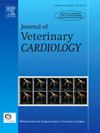猫因米诺地尔中毒引起的心力衰竭。
IF 1.3
2区 农林科学
Q2 VETERINARY SCIENCES
引用次数: 0
摘要
一只13个月大的雌性绝育俄罗斯蓝猫出现急性呼吸窘迫。胸片显示左侧充血性心力衰竭伴肺水肿的征象,超声心动图显示左室心肌增厚并伴有左房扩张。在入院后的最初几个小时,除了典型的充血性心力衰竭治疗外,由于低血压而使用多巴酚丁胺。入院后5天,猫出院,处方速尿1.11 mg/kg PO q 12 h,匹莫苯丹0.15 mg/kg PO q 12 h。1个月后超声心动图随访显示左心室壁和心房大小恢复正常,证明逐渐停药是合理的。8个月后,猫再次出现临床症状。胸片提示肺水肿复发。超声心动图再次显示肥厚表型伴中度左心房扩张。这只猫被送进医院,该病例的治疗与第一次发作类似。心肌肌钙蛋白I升高至9.89 ng/mL [本文章由计算机程序翻译,如有差异,请以英文原文为准。
Heart failure associated with minoxidil intoxication in a cat
A 13-month-old female spayed Russian blue cat was presented for acute respiratory distress. Thoracic radiographs revealed signs of left-sided congestive heart failure with pulmonary oedema, and the echocardiogram showed left ventricular myocardial thickening and concurrent left atrial dilation. In the first hours following admission, in addition to the classic management of congestive heart failure, dobutamine was used because of hypotension. The cat was discharged five days after admission with a prescription of furosemide 1.11 mg/kg PO q 12 h and pimobendan 0.15 mg/kg PO q 12 h. An echocardiographic follow-up, one month later, showed normalisation of the left ventricular walls and atrial size, justifying a gradual withdrawal of drugs. Eight months later, the cat experienced recurrence of clinical signs. Thoracic radiographs suggested a relapsing pulmonary oedema. The echocardiogram showed again a hypertrophic phenotype with moderate left atrial dilation. The cat was hospitalised, and the case was treated similarly to the first episode. Cardiac troponin I was increased to 9.89 ng/mL [<0.2 ng/mL]. Infectious disease tests were negative. Two weeks later, echocardiography showed again normalisation of left ventricular walls and atrial diameter. Treatments were gradually stopped, and subsequent echocardiographic checks showed no abnormalities. After the resolution of the second episode, it was noted that both respiratory distress events appeared after contact with a family member who was using minoxidil to treat androgenic alopecia and whose hair the cat had insistently licked. Minoxidil intoxication was retrospectively considered a likely contributor to these episodes of transient myocardial thickening associated with congestive heart failure.
求助全文
通过发布文献求助,成功后即可免费获取论文全文。
去求助
来源期刊

Journal of Veterinary Cardiology
VETERINARY SCIENCES-
CiteScore
2.50
自引率
25.00%
发文量
66
审稿时长
154 days
期刊介绍:
The mission of the Journal of Veterinary Cardiology is to publish peer-reviewed reports of the highest quality that promote greater understanding of cardiovascular disease, and enhance the health and well being of animals and humans. The Journal of Veterinary Cardiology publishes original contributions involving research and clinical practice that include prospective and retrospective studies, clinical trials, epidemiology, observational studies, and advances in applied and basic research.
The Journal invites submission of original manuscripts. Specific content areas of interest include heart failure, arrhythmias, congenital heart disease, cardiovascular medicine, surgery, hypertension, health outcomes research, diagnostic imaging, interventional techniques, genetics, molecular cardiology, and cardiovascular pathology, pharmacology, and toxicology.
 求助内容:
求助内容: 应助结果提醒方式:
应助结果提醒方式:


